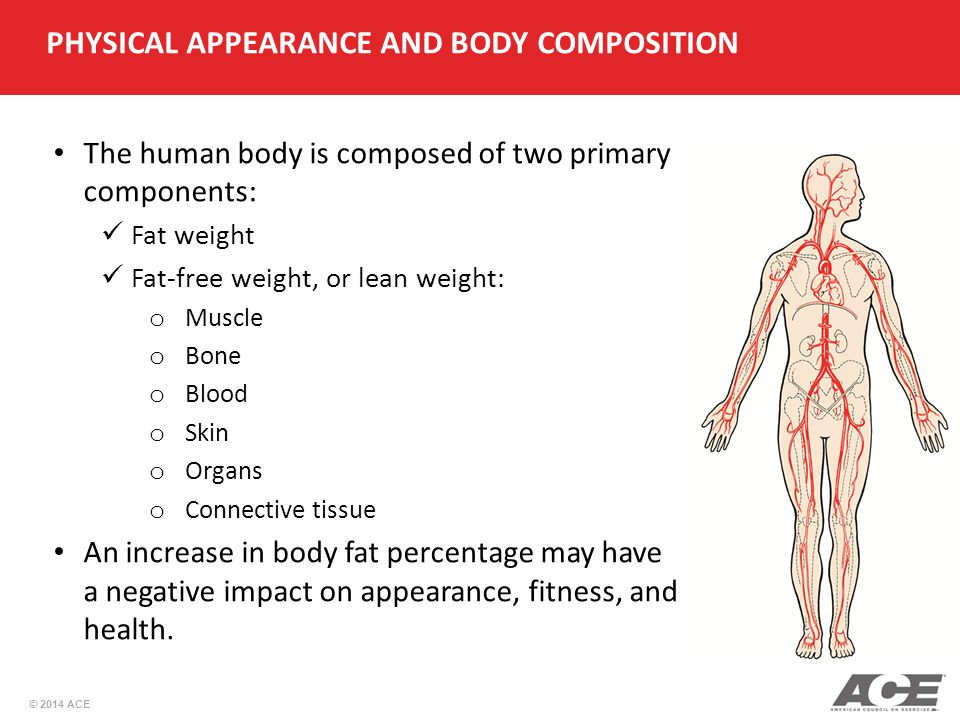
Image source: http://slideplayer.com/4900797/16/images/5/PHYSICAL+APPEARANCE+AND+BODY+COMPOSITION.jpg
There is a correlation between body composition and health ranging from mortality and morbidity to immunity, longevity, high function and athletic performance. Body composition analysis is one of the tools used in preventative, therapeutic and research applications. In the human body, body composition analysis is the clinical assessment of tissue and fluid compartments. Fat Mass is the total amount of stored lipids (fat) in the body and consists of the following types of fat:
Subcutaneous fat located directly beneath the skin. This type of fat serves as an energy reserve and serves as insulation against environmental cold.
Visceral fat lies deeper within the body. It serves as an energy reserve and as cushion between the organs.
Fat Free Mass (FFM) also called Lean Body Mass (LBM) is the total amount of non-fat (Lean) part of the body. Fat free mass is approximately 73 per cent water, 20 per cent protein and 6 per cent mineral and 1 percent ash
Body Cell Mass (BC M) is the metabolically active tissues and is the living cells of the body including muscle cells, organ cells blood cells and immune cells. It also includes the living portions of fat cells but not the stored fat lipids. The intracellular water (ICW) inside the living cells is also included in BCM. Potassium is the electrolyte of the intracellular water.
Extra cellular Mass (ECM) contains all of the metabolically inactive (non-living) parts of the body such as bone, minerals and blood plasma. Water contained outside of living cells is included in the extra cellular water. The main electrolyte in this compartment is sodium.
As mentioned before, body composition is used in preventative, therapeutic and research applications. The following can be determined through the use of body composition analysis:
Nutritional Assessment
Anti-aging Therapy
Physical performance Assessment
Weight management
Obesity
Fluid and Nutritional Assessment
Geriatrics
Lifestyles Assessment
Athletic performance
Clinical trials
Research Initiatives
What is body composition Analysis? Body composition analysis utilizes the mass and fluid compartments of the body when measurements are taken and the results are analyzed. The Bioimpedance (BIA) body composition analyzers measures body composition electronically. A qualified healthcare professional uses the result to diagnose disease, recommend treatment requirements or give treatment requirements.
The purpose of body composition analysis is to monitor and improve function. For healthy people the analysis of the Fat Free Mass and Body Cell Mass compartments can help maintain function, productivity, immunity, physical performance and longevity.
Patients/clients who are obese, the evidence has shown overwhelmingly, that obesity (excess storage of fat) has adverse effects on health and longevity.
The obesity epidemic continues to grow in the United States and has become a problem in other countries of the world. The diagnostic criteria for obesity is having a Body Mass Index (BMI) of 30 or greater or Fat Mass greater than 25 percent for males or greater than 30 percent for females.
Obesity has always been associated with health risks. Although the link to how it affects health are not fully known, recent research shows genes expression in fat tissue shown promise. The genes code for hormones is associated with insulin resistance and cardiovascular plaques.
How to treat obesity for healthy body composition
The first step is weight reduction to relieve mechanical stress on body systems.
Prescribe a healthy diet
Measure Basal Metabolic Rate
Estimate total daily caloric expenditure
Set dietary intake to equal caloric expenditure and subtract 700 calories per day
Continue diet until BMI = 30
Hormonal Reduction
The second step is to decrease the ratio of fat mass to fat-free mass to reduce the incidence of fat related hormones.
Continue with a healthy diet
Add exercise
Measure basal metabolic rate and fat-free mass
Estimate caloric expenditure= BMR
Set dietary intake=caloric expenditure 500 calories per day
Continue until percentage fat mass reaches optimal level.
What we can do to achieve healthy body composition? It is a known fact that a healthy diet and physical activity play a pivotal role in living healthy through out our lifes span. The task of maintaining healthy body weight appears to be a complex task involving many important lifestyle choices. Patients are bombarded with conflicting messages about what to eat, how much to eat, which diet is the right one, and the right exercises to do or which exercise machine to buy. In summary, you have the power to be informed and do what works best for you in achieving healthy body composition.
